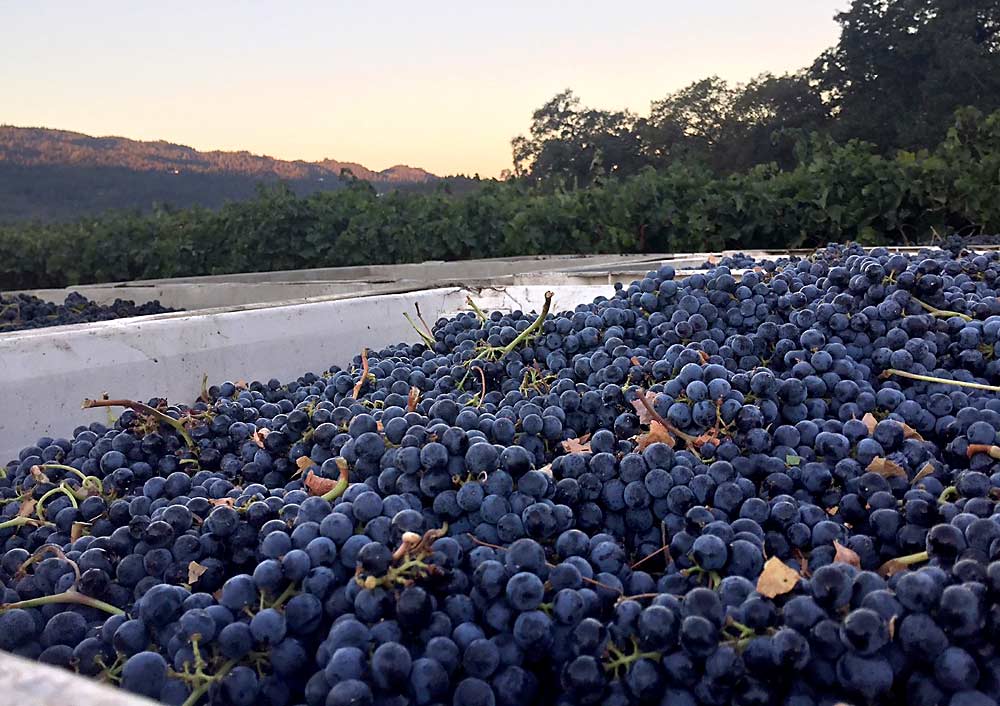
Duckhorn Vineyards’ Three Palms Vineyard in Napa Valley, California, is known for its Merlot grapes, which went into a 2014 vintage — Duckhorn Vineyards Napa Valley Merlot Three Palms Vineyard — named “Wine of the Year” by Wine Spectator in 2017. (Courtesy Duckhorn Vineyard)
U.S. Merlot went on quite a wild ride in the 1990s, rising from a little-known red to one that was on just about every wine drinker’s lips.
Then came the autumn of 2004 and the Oscar-nominated dark comedy called Sideways. One of the movie’s lead characters, a condescending wine snob, disparaged Merlot in a memorable if profane statement — “I am not drinking any (expletive) Merlot!” — and conversely extols the virtues of Pinot Noir.
The so-called “Sideways Effect” was swift, recalls Merlot grower and winemaker Ralph Hertelendy of Hertelendy Vineyards in Napa, California.
“To someone who doesn’t know anything about wine, they’re thinking, ‘Oh, I saw this movie that was critically acclaimed and seemed like a sophisticated movie, so to be a sophisticated wine drinker, I must now drink Pinot Noir and hate Merlot,’” he said. “So, the Merlot industry tanked, and the Pinot Noir industry went the other direction. It was really devastating.”
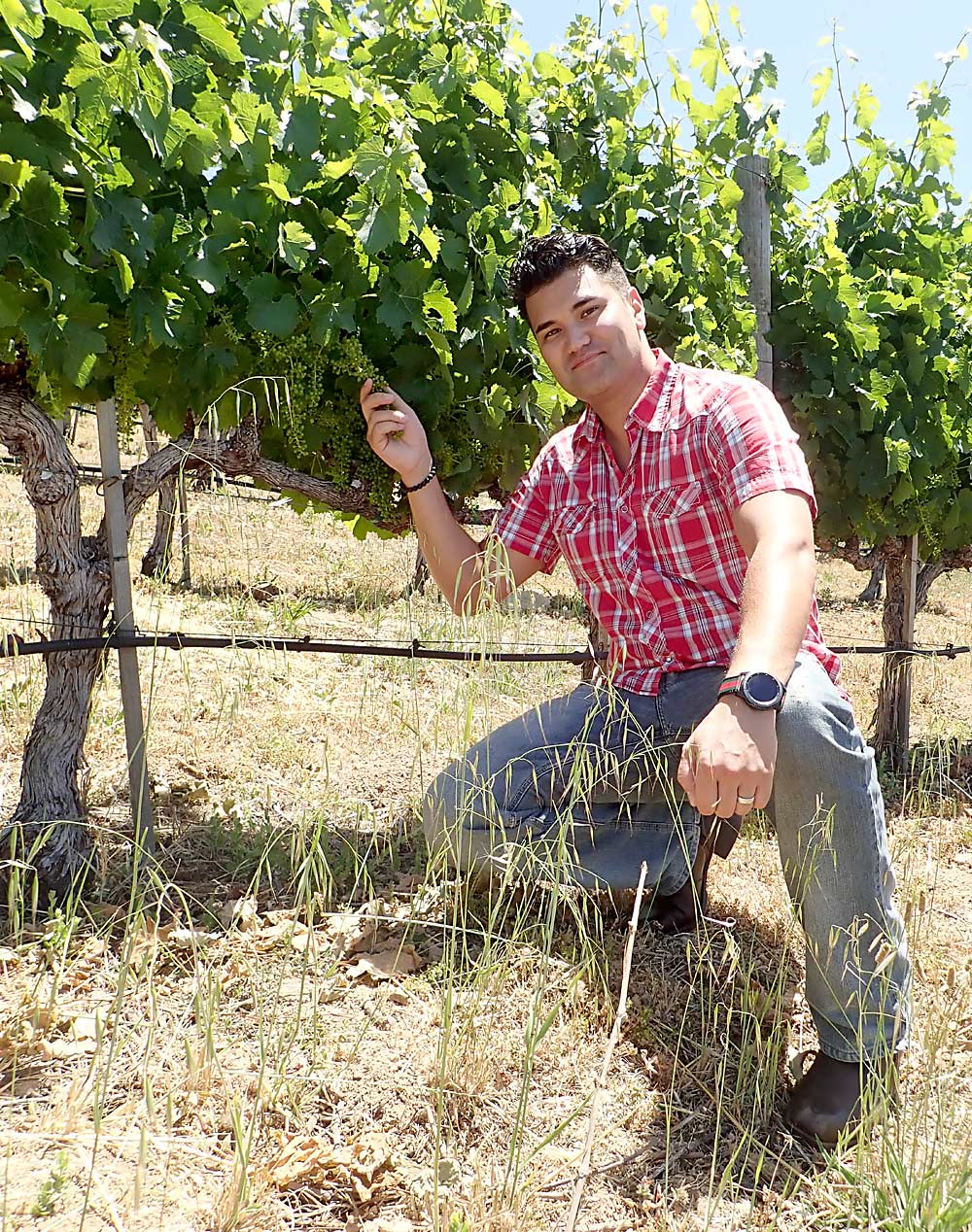
Wonderful structure, intensity and natural elegance help describe good Merlot, said Merlot grower and winemaker Ralph Hertelendy of Hertelendy Vineyards in Napa, California. The 2015 vintage of his Merlot-driven Signature Mountain Blend was ranked number 43 in the top 100 wines by the International Wine Report in 2018. (Leslie Mertz/for Good Fruit Grower)
The exact impact of the movie is difficult to pinpoint, but a 2009 Sonoma State University case study (bit.ly/SidewaysEffect) noted a statistical decline in Merlot sales of about 2 percent in the three years following the movie, and an increase in Pinot Noir sales of about 16 percent.
Despite the film’s very public blow to Merlot, it wasn’t a death knell. According to Forbes, Merlot today ranks fourth among wine grapes grown in the United States: Chardonnay is tops with 106,000 acres, followed by Cabernet Sauvignon with 101,300 acres, Pinot Noir at 61,800 acres and Merlot at 51,900 acres.
The silver lining

Alex Ryan
The film’s slam on Merlot actually turned out to be a good thing, according to Alex Ryan, president and CEO of the Duckhorn Portfolio, which has vineyards and wineries in Northern California and in Washington. Duckhorn produced the 2014 Duckhorn Vineyards Napa Valley Merlot Three Palms Vineyard that was named “Wine of the Year” by Wine Spectator magazine in 2017.
“That movie was the best thing that ever happened to Merlot,” he said. The reason: It brought attention to an unfortunate downturn that was occurring in quality.
Merlot’s meteoric rise naturally caught the attention of growers and winemakers who wanted to get in on it, and since the grape is quite adaptable, it got overplanted in speculative areas, he said.
“People were producing too much. They were producing it in areas that were marginal and, in some cases, not really suited for Merlot.” And that, Ryan said, led to some poor-quality grapes and ultimately to some poor-quality wine.
“I don’t think that was the premise of the movie, but somehow the character got wound up on it and made that statement during a time when less-than-desirable things were occurring with that varietal,” he said. That kind of thing happens: Farmers love to overproduce — it’s what they are very good at — so they’re going to go for it. But sometimes we just have to reel it in.”
The movie helped with that. “What it did was it made the bad Merlot producers stop producing Merlot because they couldn’t sell it, so it actually weaned out bad Merlot,” Hertelendy said.
Ryan concurs.
“Merlot got a great kick in the rear,” he said. “A lot of people got out of the Merlot business, and they probably shouldn’t have been in it in the first place.”
And since the movie, he noted, a large portion of those who have chosen to stay in Merlot are more committed to the varietal, have stepped up their game and are producing better Merlots to this day.
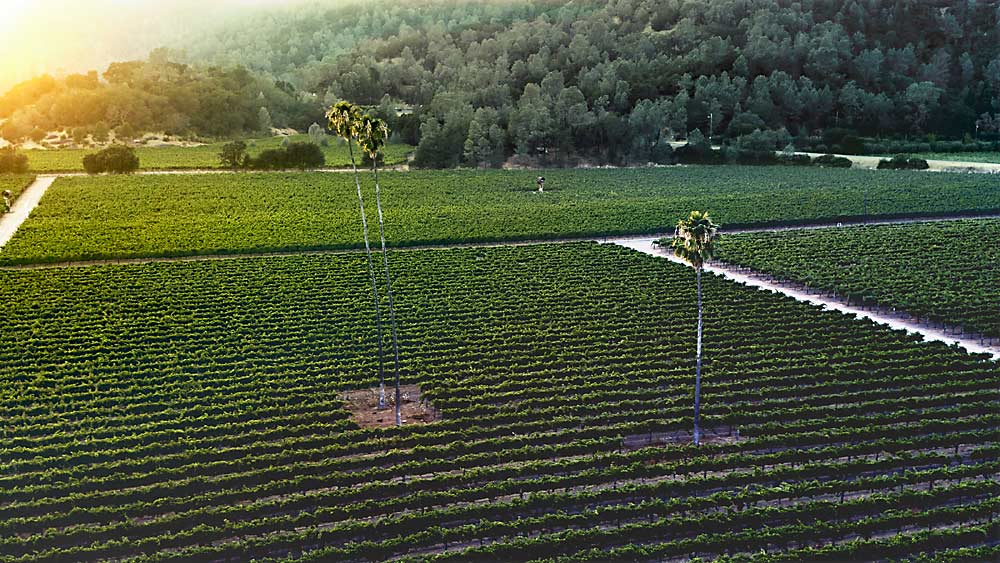
Named for its three iconic palms, the Three Palms vineyard produced the grapes that went into Duckhorn’s first vintage of Merlot in 1978. (Duckhorn acquired Three Palms in 2015.) (Courtesy Duckhorn Vineyard)
Even at Duckhorn, which made its first Merlot back in 1978 and has prided itself on its high-quality Merlots ever since, the sudden downturn “rocked me back on my heels,” he said. “At Duckhorn, we produced a little bit less by design, we refocused on our estate grapes and on our grower relationships, and we rekindled our efforts to make an even better Merlot.”
Although Ryan is admittedly no expert on lower-end Merlots, he thinks they have likely also shown improvements for the same reasons that the higher-end Merlots did. “My guess would be that the bar of quality has been lifted at all price-point levels,” he said.
A way to go
Although it’s been 15 years since the movie came out, Hertelendy said he’s still battling some lingering anti-Merlot preconceptions, even with his Signature Mountain Blend, of which the 2015 vintage was ranked number 43 in the top 100 wines by the International Wine Report in 2018.
“You have no idea how many events I go to where someone will ask what’s in my Signature Mountain Blend, and I’ll say it’s my Right Bank-style wine and it’s Merlot-driven, and they’ll say, ‘I don’t like Merlot.’ This notion has been tattooed in their brain that they’re supposed to not like Merlot,” he said.
The answer, he said, is exposure. Put Merlot under people’s noses and guide them past their prejudices.
“When you can get Merlot, especially one with volcanic terroir, it’s got wonderful structure, it’s really intense, and yet it’s a varietal that carries so much finesse and elegance just naturally,” he said. “When you get that beautiful combination of boldness with elegance, then I believe you’ve found the Holy Grail.”
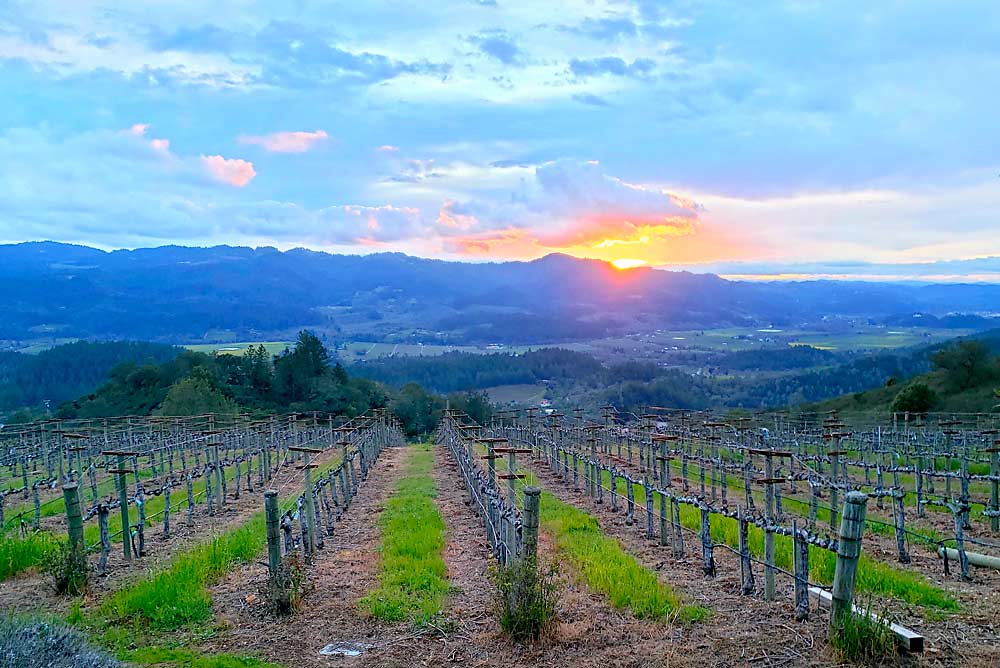
The sun sets over the mountainside Hertelendy Vineyards in March. (Courtesy Ralph Hertelendy)
Duckhorn’s founders, Dan and Margaret Duckhorn, fell in love with Merlot in 1976 for the same reasons that it remains popular today: It’s approachable, it’s luscious, it’s fruity, it’s legitimate, and it’s a big Bordeaux red wine, but it’s not overpowering. At the end of the day, people want wines that are easy to enjoy and just plain taste good, and Merlot fits that profile, Ryan said.
“It’s been a slow crawl back from the Sideways Effect. It takes us a while to make better wine and to market it, and it takes people a while to figure it out and to forget about the movie, so it took some time to get back on track,” he said. “But I think what we’re seeing now is a reflection of those actions, and ultimately it worked. The consumer is getting the benefit, and that’s good for Merlot.” •
—by Leslie Mertz
Related: Are Washington Merlots Sideways?



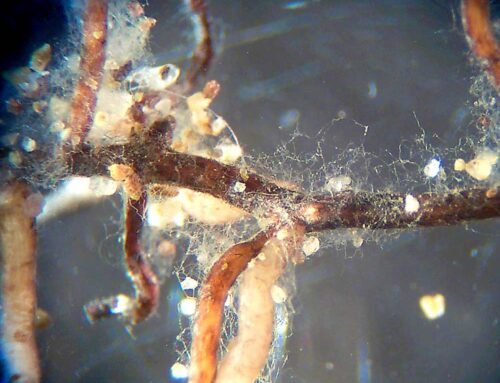
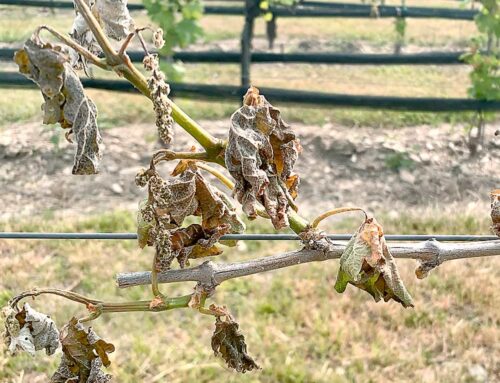

Fast forward. Replace “Merlot” with “Cabernet Sauvignon.”
Merlot’s meteoric rise naturally caught the attention of growers and winemakers who wanted to get in on it, and since the grape is quite adaptable, it got overplanted in speculative areas, he said.
“People were producing too much. They were producing it in areas that were marginal and, in some cases, not really suited for Merlot.” And that, Ryan said, led to some poor-quality grapes and ultimately to some poor-quality wine.
What a refreshing article.
I am so glad to hear another professional’s opinion on the wonderful characteristics of a great grape that can make an amazing wine when done properly.
The ripple effects of a distasteful and poorly made film may finally be well behind us.
Thank you